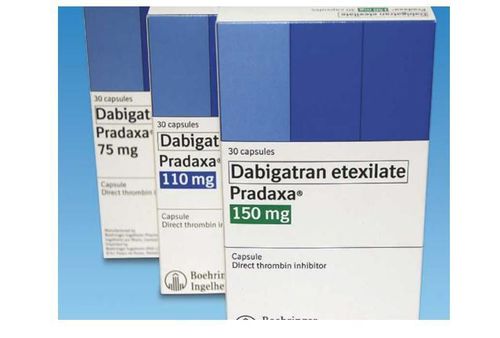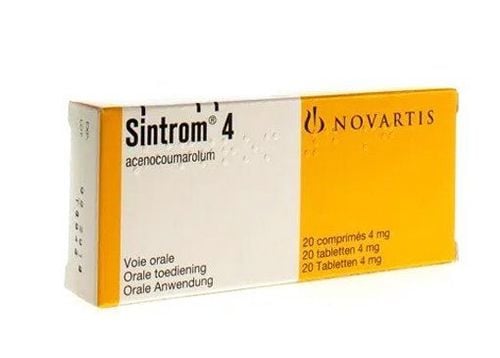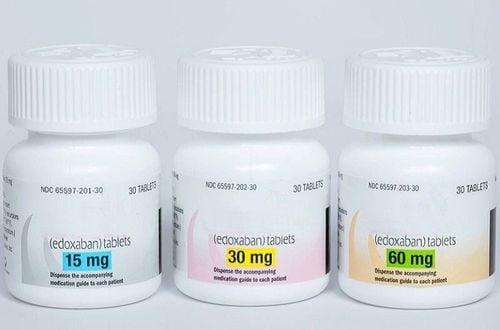This is an automatically translated article.
Xarelto 20mg drug is commonly used in the treatment and prevention of some diseases such as stroke, pulmonary embolism, deep vein thrombosis. So how does Xarelto use this medicine?
1. What is Xarelto 20mg?
Xarelto 20mg drug belongs to the group of anticoagulants, antiplatelet and fibrinolytic drugs. The ingredient in each Xarelto 20mg tablet is Rivaroxaban 20mg.
Rivaroxaban is an orally active, highly selective direct inhibitor of factor Xa. Activation of factor X to factor Xa (FXa) via endogenous and exogenous pathways plays an important role in coagulation. FXa directly converts prothrombin to thrombin via the prothrombinase complex and eventually leads to fibrin clot formation and platelet activation by thrombin. Rivaroxaban inhibits this process, so it has anticoagulant and antiplatelet effects.
Xarelto 20mg is indicated in the following cases:
Prevention of stroke and systemic embolism in patients with non-valvular atrial fibrillation with one or more risk factors such as: heart failure, increased blood pressure, diabetes, age, history of stroke or transient ischemic attack. Treatment of deep vein thrombosis, pulmonary embolism. Prophylaxis of deep vein thrombosis and recurrent pulmonary embolism. Xarelto 20mg is contraindicated in the following cases:
People with hypersensitivity to rivaroxaban or any of its ingredients. Patients with clinical bleeding such as intracranial bleeding, gastrointestinal bleeding. Persons being treated with other anticoagulants, except in specific cases such as during the transition from one anticoagulant to another or when unfractionated heparin is used to maintain tube openness. central venous or arterial catheter. Patients with liver disease associated with coagulopathy and clinically relevant bleeding risk including cirrhotic patients with Child Pugh B and C ratings. Pregnancy and lactation. mom.
2. Dosage and how to use Xarelto 20mg
How to take Xarelto 20mg as follows:
The drug is taken orally, should be taken with food. Xarelto tablets can be crushed and mixed with water or soft food just before taking orally. After taking the medicine in this way, you should continue to eat food immediately. Crushed Xarelto 20mg tablets can be given through a nasogastric tube, the crushed drug must be administered with a small amount of water through a nasogastric tube then filled with water. This is followed by enteral feeding. The recommended dose of Xarelto 20mg in the specific cases is as follows:
Prevention of stroke and systemic embolism in patients with atrial fibrillation (SPAF): Use a dose of 20mg once daily Treatment and prevention of recurrence Deep vein thrombosis and pulmonary embolism: Day 1 to day 21: Use dose 15mg x 2 times/day, maximum 30mg/day. Day 22 and the following days: Use dose 20mg x 1 time/day, maximum 20mg/day. Duration of treatment should be carefully weighed against the individual patient benefit against the risk of bleeding. Switching from Vitamin K antagonists to Xarelto 20mg: For patients on stroke and systemic embolism prophylaxis: Vitamin K antagonist therapy should be discontinued and Xarelto started when INR < 3. For patients For the treatment and prevention of recurrent deep vein thrombosis and pulmonary embolism, vitamin K antagonist therapy should be discontinued and Xarelto initiated when the INR is < 2.5. Switching from Xarelto to Vitamin K antagonists: Concomitant use of Xarelto and vitamin K antagonists is recommended until INR 2.20. During the first two days of the drug transition period, an INR-adjusted dose of vitamin K antagonist is administered after the standard dose of vitamin K antagonist. When patients are receiving Xarelto 20mg and vitamin K antagonists concurrently, the index should be checked. The INR is before the next dose of Xarelto 20mg but 24 hours after the previous dose. Switching from parenteral anticoagulants to Xarelto 20mg: The parenteral anticoagulants should be discontinued and Xarelto should be started approximately 2 hours before the next injection of the parenteral agent or at the time of discontinuation of the intravenous infusion. continuous. Switching from Xarelto to parenteral anticoagulants: Stop taking Xarelto and start the first dose of parenteral anticoagulant at the time of the next Xarelto dose. Dosage of Xarelto 20mg for special subjects:
Patients with moderate (CrCl) 30-49 mL/min or severe (CrCl 15-29 mL/min) renal impairment: For the prevention of stroke and systemic embolism in patients with nonvalvular atrial fibrillation (SPAF), the recommended dose is 15 mg once daily. In the treatment and prevention of recurrence of deep vein thrombosis and pulmonary embolism: Use a therapeutic dose of 15 mg twice daily for the first 3 weeks. Thereafter, using the recommended dose of 20 mg once daily, consideration should be given to reducing the dose from 20 mg once daily to 15 mg once daily if the risk of bleeding is assessed to outweigh the risk of recurrent venous thrombosis. deep vein and pulmonary embolism. Elderly: No dose adjustment is required. Children: Xarelto 20mg is not recommended for children under 18 years of age. Patients with nonvalvular atrial fibrillation who have undergone percutaneous coronary intervention with stenting: Use 15 mg Xarelto once daily or 10 mg Xarelto once daily for patients with moderate renal impairment, in addition to regimen with P2Y12 inhibitors. Use this regimen for up to 12 months after percutaneous stenting. After completion of antiplatelet therapy, the dose of Xarelto 20 mg should be increased to the standard dose for patients with nonvalvular atrial fibrillation. Rare cases of overdose of Xarelto 20 mg up to 600 mg have been reported, without bleeding complications or other adverse reactions. Currently, we do not have a specific antidote that antagonizes the pharmacodynamic effects of rivaroxaban. When a patient takes Xarelto 20mg, if bleeding complications occur, the next dose should be withheld or completely discontinued if appropriate, and symptomatic treatment should be instituted if necessary.
If you forget a dose of Xarelto 20mg, use it as soon as possible. However, if it is almost time for your next dose, skip the missed dose and take your next dose at the scheduled time.
3. Side effects of Xarelto 20mg
When using Xarelto 20mg, you may experience side effects.
Common side effects of Xarelto 20mg include:
Anemia. Eye bleeding. Bleeding gums, gastrointestinal bleeding. Abdominal pain, indigestion, nausea, vomiting, constipation, diarrhea, vomiting. Pain in the limb. Postoperative bleeding, contusion. Headache, dizziness. Fever, peripheral edema, decreased strength, general energy Nosebleed, pruritus, skin hemorrhage, skin hematoma,... Uncommon side effects of Xarelto 20mg include:
Increased platelets. Fast heart beat. Dry mouth. Wound exudate Cerebral and intracranial bleeding, syncope. Joint hematoma Feeling uncomfortable, decreased liver function, urticaria,... When experiencing side effects of Xarelto 20mg drug, you need to stop using and notify your doctor or immediately go to the nearest medical facility for treatment. handled in a timely manner.
4. Interaction of Xarelto 20mg with other drugs
The concomitant use of Xarelto 20mg with systemic azole antifungals such as itraconazole, ketoconazole, voriconazole and posaconazole or HIV protease inhibitors is not recommended. Concomitant administration of Xarelto 20mg with rifampicin leads to a decrease in the pharmacodynamic effects of the drug. Phenytoin, carbamazepine, phenobarbitone or St. John's Wort when co-administered may also lead to decreased plasma concentrations of rivaroxaban. It should be noted that you are being treated concomitantly with any other clotting-related drugs such as enoxaparin, NSAIDs, platelet aggregation inhibitors, warfarin, etc. The above is all important information. About Xarelto 20mg. You need to know the information to use the drug effectively.
Please dial HOTLINE for more information or register for an appointment HERE. Download MyVinmec app to make appointments faster and to manage your bookings easily.













